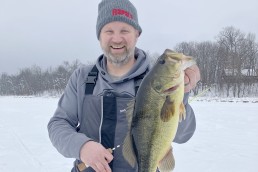Bassin’ Through the Ice
SHARE THIS POST
Here in the Midwest, walleyes and panfish get all the attention once the lakes freeze over. They are generally plentiful throughout most systems, willing to bite and excellent table fare. Often ignored by most ice anglers, bass provide a good alternative for those looking to have some fun with America’s most popular freshwater gamefish.
Many anglers mistakenly say that bass put on the feedbag in the fall, gorge themselves, and then don’t eat throughout the winter. This is not the case. Bass are cold-blooded creatures whose body temperatures mimic the surrounding water. So as water temperatures cool, so does their metabolism and diet. Meals can last much longer in cold water. Bite-sized baits are more appropriate as meals during the winter months. Bigger baits, such as jigging spoons or Rippin’ Raps, still work on occasion; they just won’t get as many bites as smaller panfish-sized baits.
For bass anglers, it’s about ultimate downsizing. During the open-water season there is a lot of emphasis put on downsizing baits to get bites—especially when body a body of water receives a lot of fishing pressure or when cold fronts come through and affect the bite.
Through the ice, you are far better off using small jigs—the same ones you would use for crappies or bluegills. The challenge with them is that you typically want to match that with light line, such as 2- or 3-pound mono or fluorocarbon such as Sufix 100% fluorocarbon. Catching 1- to 2-pounders is fun and really puts the rod, reel and line to the test, but it works. If you connect with a 3- to 4-pounder (or larger), you are really outmatched, and it normally doesn’t end well. Breakoffs are common, especially in shallow water with weeds. If you are in deep water such as 15 to 20 feet, it can work a little better because fish can get tired out down near bottom, giving you a fighting chance to get it up through the hole.
If you are targeting 10 to 12 feet on weed flats or anywhere near weeds, a minimum of 5-pound fluorocarbon is necessary. This will provide the line strength necessary to keep the fish hooked and be able to get it through the ice while allowing you to feel the jig below.
With heavier line, it helps to use a little bit heavier jig. You want to be able to work and control the jig below. Additionally, you need to have a decent-sized hook gap and a strong enough hook to withstand the weight of the bass without breaking. The VMC Tungsten Wax Tail jig fits all those criteria. When it is jigged slowly, the rat-like tail moves effortlessly and makes it look like a bite-sized minnow/insect. But don’t over work the bait, especially when the bass can see it. Once they get near, they oftentimes slide over and barely open their mouths when they hit the bait. If you are still trying to jig or impart action, you will likely pop the jig above their open mouths, and they will miss it and move on. So, give it little jigging motions until the fish gets near, then just hold it steady and wait for the hit.
Are you enjoying this post?
You can be among the first to get the latest info on where to go, what to use and how to use it!
Some of the best areas to find wintertime largemouths are vegetated bays that have sufficient depth, such as 10 to 12 feet. You can also find them near weedy areas out in main-lake basins, such as weedy points or weedy flats in the 8- to 15-foot depths. You can catch them early and late in the day but expect prime time to run from late morning through midday.
Ice electronics help you be more effective. However, in clear-water situations, you can often watch the action through the hole if you’re fishing shallow and your fish house blocks enough light. Underwater cameras are also good choices in clear water; just set up the camera a sufficient distance away so you don’t run the risk of the fish getting tangled in the cord.
If you are a hardcore bass angler, don’t let ice deter you from chasing after them. Put your fish-finding skills to the test, seek out the available cover and work on downsizing your tackle and lures. Put in a little time and you will certainly be able to rough up your thumb on a bass mouth or two. Even though it is really cold water, you will be surprised at how eager they are to bite. It’s not the same as catching them in the slop or on a Chatterbait, but it is still a lot of fun.
For helpful bass fishing insight, check out the articles in every issue of MidWest Outdoors. Subscribe on our website.
MWO
SHARE THIS POST
You may also like...
Nothing found.
Did you enjoy this post?
You can be among the first to get the latest info on where to go, what to use and how to use it!
Steve Mattson
Steve Mattson has been writing articles for MidWest Outdoors since 2001. He is a driven angler, guide and sponsored tournament pro who has won both bass and panfish tournaments, and has placed in walleye and pike events. He resides in northern Minnesota and enjoys helping others catch more fish. For more info: mattsonangling.com and @mattsonangling.
